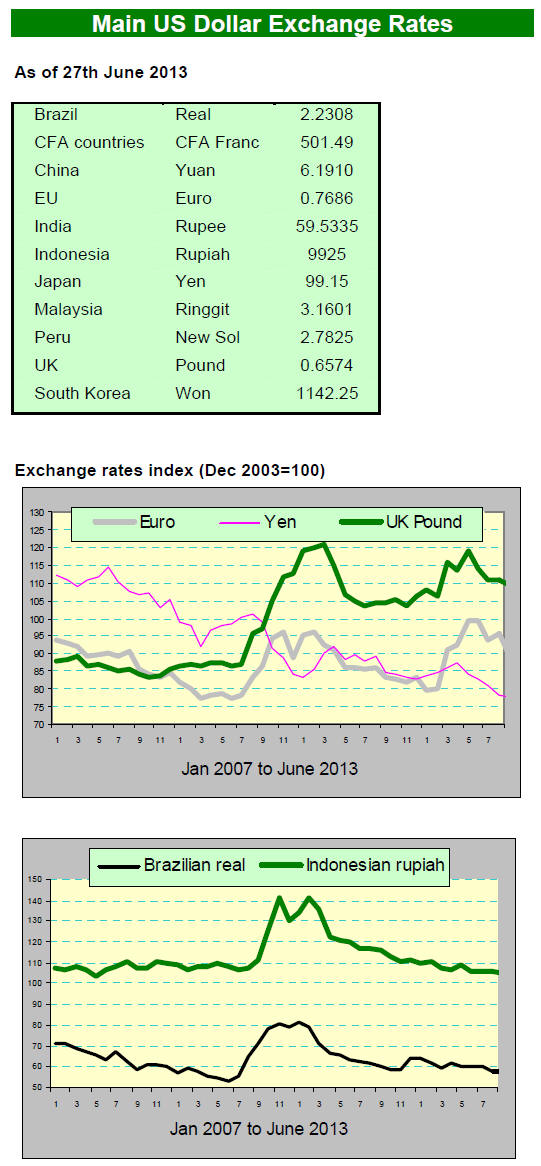2. GHANA
Ghanaian entrepreneurs preparing for
international trade fairs
Ghanaian businesses are preparing to attend two international timber trade
fairs scheduled for later in the year.
One fair is the Timber Expo to be held at the Birmingham, UK, National
Exhibition Centre on 24 ¨C 25 September. The Expo will showcase the latest
products, innovations and developments from the UK and international timber
sectors.
The organisers expect around 150 exhibitors at the Timber Expo which is
considered one of the best in Europe for the building and timber industries.
Ghanaian exporters will also participate in an international forest products
exhibition, the Yiwu Exhibition, which will be held in China. This trade
fair will provide the opportunity for Ghana¡¯s timber exporters to promote
their products in a market with enormous potential.
The Ghana Investment Promotion Centre (GIPC), the Forestry Commission of
Ghana (FCG), Ghana Free Zones Board (GFZB) and the Minerals Commission will
attend the Yiwu Exhibition.
Decisive action on forest degradation
The government has taken decisive action that should drastically reduce
degradation of the country¡¯s forests. The Forestry Commission (FC) is in
talks with the Attorney General¡¯s department to ensure speedy prosecution of
those caught breaking the law.
This was made known by the deputy Minister of Lands and Natural Resources,
Ms. Barbara Serwaah Asamoah, during a 2-day visit to the Ashanti Region
where she inspected the Fomanso Forest Reserve in the Asante-Akim South
District.
She expressed the government¡¯s determination to get denuded reserves
replanted under the National Forest Plantation Development Programme (NFPDP).
The Government of Ghana has been implementing an ambitious plantation
programme under the NFPDP since 2001 with a target of establishing 20,000
ha. of tree plantations each year.
Last month, the Forestry Commission and Form Ghana (a forest plantation
management company based in central Ghana) signed a 50-year Public-Private
Partnership (PPP) Lease Agreement to jointly reforest an estimated 14,000 ha
of degraded forest land within the Tain Tributaries II Forest Reserve near
Berekum, in the Brong Ahafo Region.
The Forestry Commission, Form Ghana and the Berekum Traditional Council
signed a benefit sharing agreement to formally document the responsibilities
for project sustainability and control and on benefits to all stakeholders.
According to the CEO of the Forestry Commission, this kind of partnership
fits well within the Government¡¯s policy framework for plantation
development.
The CEO indicated that "the future of plantation development in Ghana can be
a great success if the private sector is enabled to play a key role".
GDP dragged down by poor performance of industrial sector
Ghana¡¯s unadjusted Gross Domestic Product (GDP) growth stood at 6.7%
year-on-year in the first quarter of 2013 compared with 10.3% a year ago.
The services and agriculture sectors recorded 12% and 1.1% growth
respectively while industry recorded negative growth of 0.8% as the power
crisis in the country has affected factory output.
In related news, the Statistical Service has
announced that the May 2013 consumer price index inflation, calculated on a
rebased index with fresh items to reflect the current consumer priorities,
stood at 11.1% year-on-year. The May inflation figure was 10.9% under the
previous model.
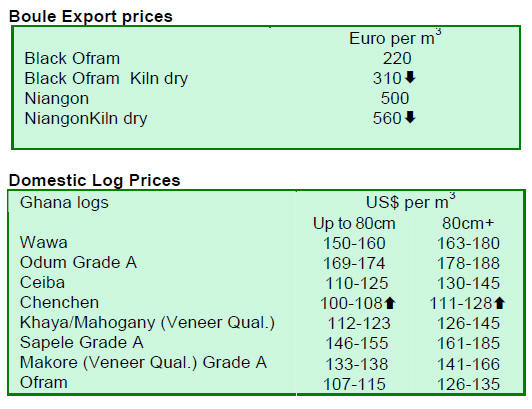

3. MALAYSIA
Fire management the answer to limiting
annual smoke pollution
Many parts of Malaysia are covered by smoke haze, an unhealthy situation
made worse by the current dry weather conditions. The Air Pollutant Index
(API) reached ¡°very unhealthy¡± levels in some populated areas in late June.
The Malaysian government's index for air pollution reached a measurement of
746 on the worst days in the southern district of Muar, far above the
threshold of 300 for hazardous air quality. This pollution has heightened
public awareness of environmental issues.
The smoke, the result of the annual burning by farmers and plantation owners
in Indonesia, is drifting across the Straits of Malacca and seriously
affecting southern Malaysia.
After the serious forest fires in Indonesia in 1996/7 ITTO implemented
several projects on various aspects of forest fire management in Indonesia
and Malaysia with good effect.
Farmers and plantation companies are now more aware of the dangers of fires
spreading to the forest and apply fire management principles but clearly
more needs to be done.
Indonesian authorities say they have fire fighters in the affected areas and
are investigating whether legal action should be taken against those
responsible.
Forestry ¡®peace deal¡¯ delivers payout to Sarawak plymill in Tasmania
In the midst of the political leadership tussle in Australia came news that
the Australian government has agreed to pay compensation to a Sarawak timber
company operating in Tasmania.
The Malaysian news agency Bernama reported that the Australian Government
has agreed to pay Sarawak-owned timber company Ta Ann A$26 million in
compensation for wood supply the company is giving up as part of the
forestry ¡®peace deal¡¯.
Under the deal, Ta Ann would lose access to forest resources which would
have yielded about 108,000 cubic metres or 40 per cent of its peeler log
supply.
Ta Ann said this means its mills in the Huon and at Smithton in Tasmania
will now have to run below capacity. The company said the compensation
payout will ensure all the 90 plus employees keep their jobs.
The announcement of the settlement has been
welcomed by ¡®peace¡¯ deal signatories, including the Wilderness Society's
Warwick Jordan.
Quiet log market as buyers wait for Indonesian decision on log exports
Sarawak log exporters are saying that market sentiment is uncertain as some
log buyers are waiting to see if the Indonesian authorities decide to allow
the export of plantation logs.

Sabah TLAS being tested
In Sabah, the timber industry and State Authorities are working together on
the Sabah Timber Legality Assurance Scheme (TLAS) as part of the VPA which
Sabah hopes to sign with EU.
Sabah mills are now undergoing compliance audits as they test the Sabah TLAS
criterion on ¡°Issuance, renewal and upgrading of mill license and conditions
for operation¡±, as well as ¡°Worker safety and health¡±.
All wood processing mills are required to be licensed with the Sabah
Forestry Department and must comply with mill license conditions including
submission of monthly mill production returns and maintenance of log
delivery records.
The industry is also testing its TLAS principle on ¡°Trade and Customs¡±,
especially on meeting export regulations.
Exporting companies must have a valid export license from the Forestry
Department and must comply with state and national regulations pertaining to
the export of wood products.
¡¡
4. INDONESIA
Exports doing well despite delays in
ratification of VPA
With or without the Voluntary Partnership Agreement (VPA) on timber with the
European Union (EU), Indonesia¡¯s timber exports have increased significantly
because the country has an effective timber legality assurance system which
EU importers find satisfies their need to meet the due diligence
requirements of the EUTR.
Colin Crooks, deputy head of the EU delegation to Indonesia, said the volume
of Indonesian timber entering Europe in the first quarter of this year had
more than doubled compared to last year.
Indonesia¡¯s Ministry of Trade has data showing wood product exports, mostly
furniture, more than doubled to US$416 million in the first quarter of this
year, compared to US$194 million in the same period last year.
The signing and ratification of the VPA has been delayed in the EU because
documents have to be translated into all 22 of the EU languages.
Indonesia¡¯s timber legality scheme is being assessed, a process that is
required before it can be formally accepted as meeting the VPA requirements.
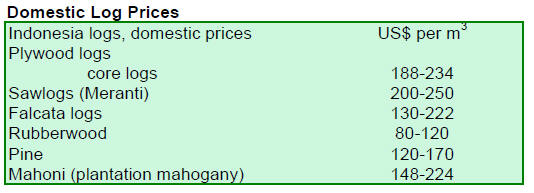
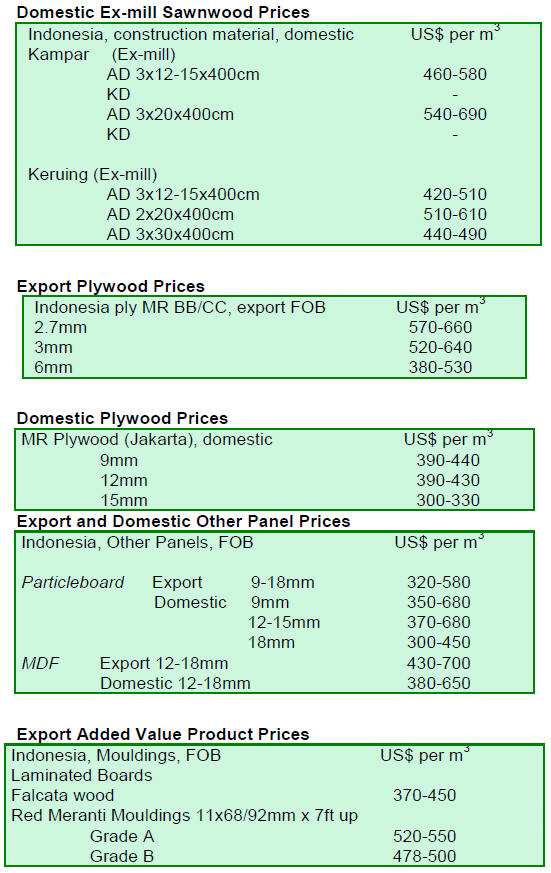
5. MYANMAR
Teak log sales
The following prices were recorded for teak log sales during competitive
bidding on 21st and 24th June 2013 during the Myanma Timber Enterprise
tender.
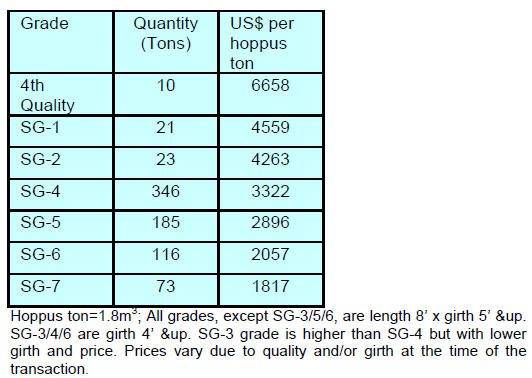
In addition to the grades mentioned in the table
above teak logs of other specifications are available. Some 8 tons of short
logs measuring length 6 feet to 7 feet girth were sold at an average price
of US$1900 per ton hoppus measure.
Log-ends with lengths less than 5 feet are also sold and during the recent
tender the average price for this specification was US$1225 per ton hoppus
measure.
Short logs and log ends are usually by-products accumulated from
cross-cutting high quality veneer logs.
Short logs and log-ends are usually purchased by domestic or Thai buyers.
Apart from Teak, other hardwoods are not attracting much demand despite the
likelihood of a log export ban being introduced in April 2014.
Demand for teak logs is subdued at present as buyers are not expanding
stocks any further. Buyers from China and India are not very active which
has led to weakening demand.
Resource contracts could be renegotiated
Mizzima news ran a story recently saying a leading US think tank mentioned
that the Myanmar government plans to renegotiate billions of dollars of
natural resource deals to impose tougher environmental standards.
It added that Myanmar is a candidate to join the Extractive Industries
Transparency Initiative, which seeks to set international standards in
countries with major resource revenues.
South Korean firms bidding for business
The Irrawaddy News reported in its Business Roundup that a South Korean
trade delegation, led by Finance Minister Hyun Oh-seok, visited Myanmar amid
reports that the Korean government intended to triple its development aid
and loans to US$100 million.
Korean firms are bidding for contracts to help develop the planned new
Yangon airport at Hanthawaddy (near Bago).
¡¡
6.
INDIA
Timber imports through Kandla port
During the period April 2012 to March 2013 Kandla port handled imports of
4,354,300 cubic metres of timber. Out of the total imports coniferous
timbers totalled 1,703,265 cu.m and hardwoods 2,651,035 cu.m. Of the
hardwoods imported teak accounted for 470,535 cu.m.
The main hardwoods imported were identified in the report for the early part
of June 2013.

Overall timber shipments via Kandla port were 5%
higher in 2012-13 compared to 2011-12 and the indications are that shipments
are still increasing but, with the Indian rupee depreciating and prices
rising, the pace of growth in imports may slow in the coming months.
Surprising recovery in 2012 wood product exports
The 2012 export figures have been published, showing an improvement year on
year.
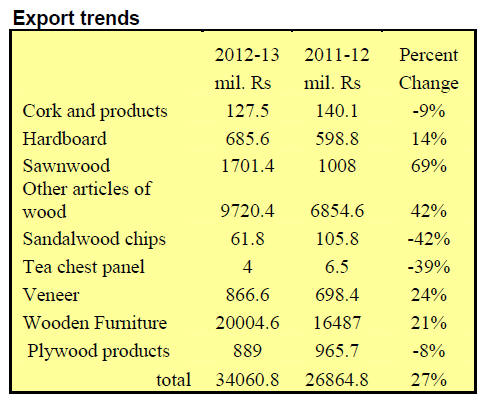
Exports of wood products (incl. cork and cork
items) grew by 27% in 2012-13 compared to a year earlier. A steep rise in
export values was recorded for most products except cork and cork products,
sandalwood chips, tea chest panels and other plywood products.
Correction
In Volume 17 Number 11, 1st ¨C 15th June 2013 the table, Imports of teak and
other hardwoods April 2012 to March 2013, refers to shipments through Kandla
port only.
India and Malaysia competing for Mid-East demand for sawn meranti
Indian mills are reportedly doing well sawing imported Sarawak meranti logs
and marketing sawn meranti in Middle East markets in competition with
sawnwood from Peninsula Malaysian mills. Analysts presume this is possible
because labour costs are lower in India compared to rates in Malaysia.
Hardwood auction prices in central India
In recent auctions at government forest depots in Khiria, Timarni and
Ashapur in Central India approximately 5,000 cubic metres of mainly teak and
some of Haldu and Laurel were sold.
Due to the rising costs of imported logs and because the domestic logs at
these auctions were of good quality prices were higher than in previous
auctions. Average prices per cubic foot ex-depots are shown below.

Domestic prices for sawnwood
Domestic ex-sawmill prices for air dried sawnwood per cubic foot are
unchanged but are likely to rise in the short term.
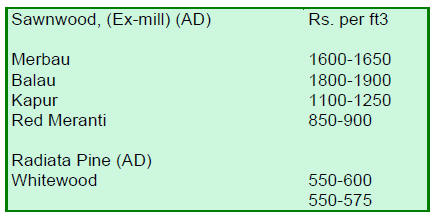
Myanmar teak sawnwood processed in India
Competition from plantation teak and durable non-teak hardwoods is a barrier
to price increases for locally sawn imported teak such that prices remain
unchanged.

Plantation teak imports affected by rupee dollar
exchange
Arrivals of plantation teak shipments have been affected by the strong
dollar and resultant higher landed costs in rupees.
Some minor adjustments in prices has beeen observed but generally prices
have remained steady as exchange rates in supply countries have also
adjusted to the stronger dollar. Current prices, C & F Indian ports per
cubic metre are shown below.
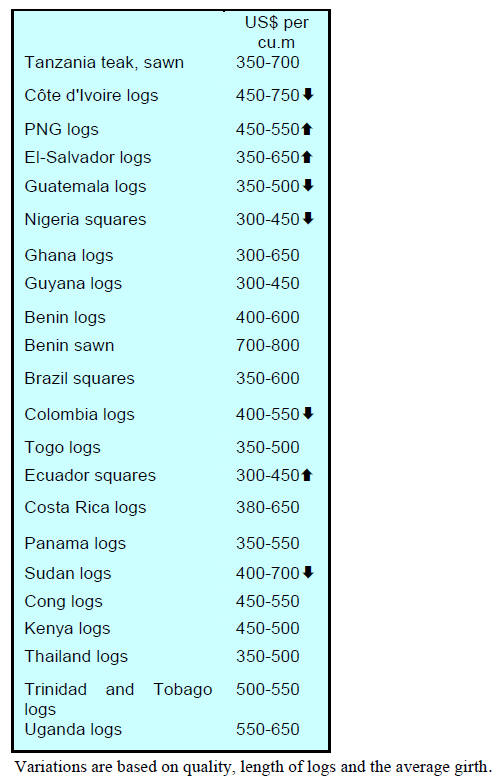
Prices for imported sawnwood
Ex-wharehouse prices for imported kiln dry (12% mc.) sawnwood per cu.ft are
shown below
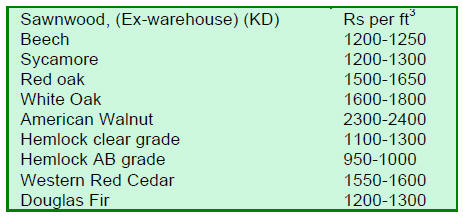
Plywood producers raise prices
Inflationary pressure and weak Rupee has forced the manufacturers to
increase the rates. Revised prices are shown below.
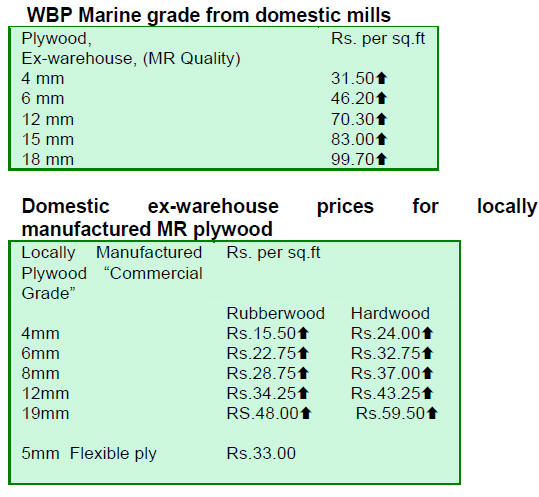
7.
BRAZIL
Central Bank raises interest rates to
tame inflation
Brazil¡¯s Consumer Price Index (IPCA) increased by 0.37% in May, which was
0.18 percentage point below the rate of 0.55% recorded in April. This is the
lowest monthly IPCA rate since June 2012 (0.08%). The accumulated IPCA rate
for the year to May was 2.88% which is lower than the 2.24% rate in the same
period in 2012.
In May 2013 the average exchange rate was BRL 2.03/USD while in May last
year the rate was BRL 1.99/BRL indicating a slight depreciation of the real
against the dollar.
The Monetary Policy Committee (Copom) of the Brazilian Central Bank (BC)
raised the Selic rate by 0.50 percentage point at the end of May to an
annualized rate of 8%. The Committee considers this will contribute to
capping inflation.
Potential of Parica timber examined
Plantations of native species are not common in Brazil but some have been
established for commercial use and for recovery of degraded forests.
Among the species planted is Parica (Schyzolobium parahybum var. amazonicum)
a fast growing tree which yields timber with good characteristics.
The favourable characteristics have caught the attention of veneer and
plywood manufacturers however there is a lack of information on the
technical and working properties of the wood. Most past research on Parica
has been related to its silviculture.
Researchers at the Federal University of Lavras (UFLA), have carried out
work to document the characteristics of this timber.
The research involved describing and quantifying the structure of Parica
from different regions of the Amazon, determining the physical and chemical
properties of the wood both in commercial plantations and natural forests
and conducting dendrochronological studies.
Tropical plywood exports continue to decline
In May 2013 the value of wood products exports (except pulp and paper)
increased 8.8% compared to levels in May 2012, rising from US$204.1 million
to US$ 222.0 million.
The value of pine sawnwood exports fell 14.9% in May 2013 compared to May
2012, from US$14.1 million to US$12.0 million. In terms of volume, exports
declined 17.7%, from 64,500 cu.m to 53,100 cu.m in the same period.
Exports of tropical sawnwood increased 3.0% in May from 33,200 cu.m in May
2012 to 34,200 cu.m in May this year. The value of tropical sawnwood exports
rose 4.3% from US$16.2 million in May 2012 to US$16.9 million this year.
Pine plywood exports increased 13.6% in value in May 2013 compared to May
2012, from US$35.9 million to US$40.8 million. The volume of pine plywood
exports also increased (14.7%) from 91,300 cu.m to 104,700 cu.m. over the
same period.
On the other hand, tropical plywood exports which are now very small, fell
9.4% from 5,300 cu.m in May 2012 to 4,800 cu.m in May 2013.
The value of exports of tropical plywood dropped 19.4%, from US$3.6 million
in May 2012 to US$2.9 million in May 2013.
A 4.4% increase in wooden furniture exports was recorded in May 2013
compared to the same period in 2012. Exports rose from US$41.0 million in
May 2012 to US$42.8 million in May this year.
Brazilian furniture does well in Dubai fair
Eight Brazilian companies participated in the¡¯ Index Dubai 2013¡¯ fair, which
took place on 20 ¨C 23 May.
During the event, orders worth around US$800,000 were attracted and the
value of prospective business for the next 12 months was put at US$2.2
million. ¡®Index Dubai 2013¡¯ attracted more than 800 exhibitors from 47
countries and more than 20,000 visitors.
Participation in trade fairs in Bahrain, Kuwait,
Oman, Qatar, Saudi Arabia and the United Arab Emirates has enabled Brazilian
businesses to generate significant income.
Reports suggest that between January and March this year these countries
invested US$3.3 billion in their residential housing sector which provides a
great opportunity for wood product exporters.
Strengthening sustainable forest management
A conference on Forests for Future Generations was held in mid-June in
Berlin, Germany. The discussions focused on public and private
responsibility for sustainability, initiatives to support forest management
and responsible trade by countries that produce, process and buy tropical
wood or wood products.
The meeting brought together about 100 participants, including government
officials, representatives of industry and civil society and the Brazilian
Forest Service participated.
The main themes discussed included promotion of sustainable forest
management in tropical regions, the expansion of the scope of legal and
sustainable forest products, possible partnerships among the public sector,
civil society and the private sector, the awareness of consumers and
influence of buyers and civil society on actions for government decisions.
Price trends
Average prices of wood products in Brazilian real did not change over the
past two weeks.
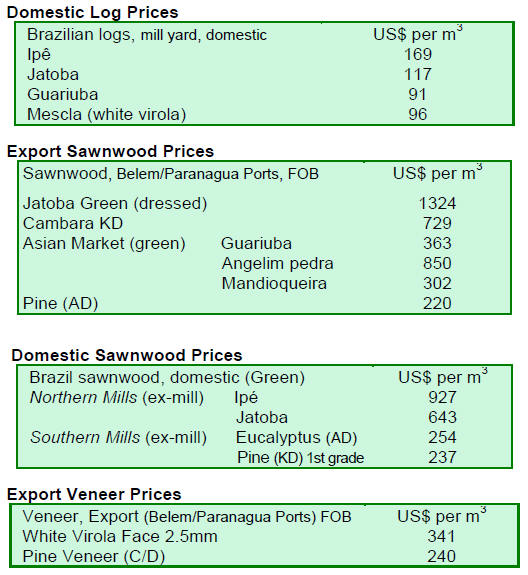
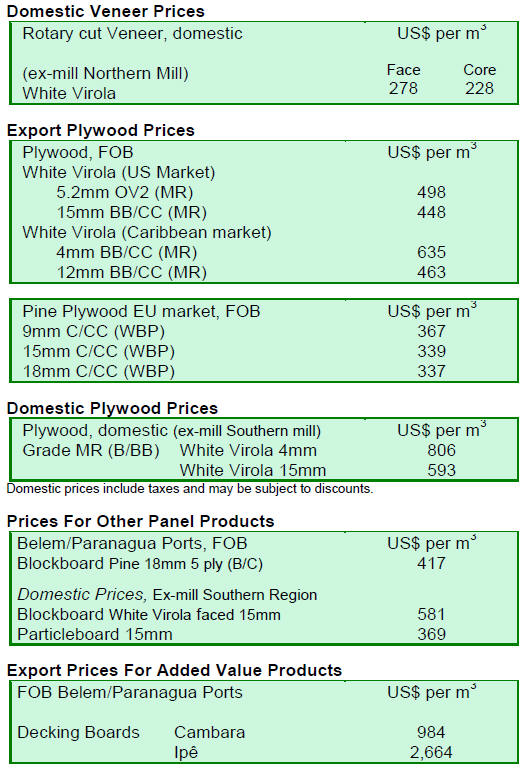
8. PERU
Forum for sustainable development created
in Loreto
In the first week of June a wide range of stakeholders met to discuss the
future of Loreto after reviewing the findings of a study "Sustainable Loreto
to 2021" prepared by researcher Marc Dourojeanni.
This study recommended integrated planning as critical to achieving
development in Loreto and for minimising conflicts, irrational use of
natural resources and the proliferation of illegal activities.
Dourojeanni, said what happens in Loreto in the coming years will have an
impact nationally as this region has nearly a third of the land area of the
country.
He said "although it is an important area in Peru, Loreto has the worst
power supply in the country, the worst infrastructure for telecommunications
and is almost completely isolated from the rest of the nation¡±.
At the moment there are at least 36 different plans for development of the
region, some of which are contradictory. It is hoped these anomalies can be
addressed through the newly established "Forum for Sustainable Development
Loreto ".
The Forum will address substantive issues such as
communications, energy planning, mining activities and land tenure amongst
others.
Forest concession atlas launched
The Council of Ministers has launched an atlas of forest concession as a
tool to identify deforestation from various practices.
The Council will, by utilising the resources of OSINFOR, seek to prevent the
misuse of the forest resources.It took around 10 years for an institutional
system for forest concession allocation to be enactment into law (Law No.
27308, Law of Forestry and Wildlife) and the new atlas is perceived as
providing an integrated view of forest management and utilization.
French government consulting firm opens office in Peru
ONF International, the international arm ONF of France (www.onfinternational.org/en.html),
is a consulting company and it will open an office in Peru.
ONF International (ONFI) is an international environmental consulting
company specialising in sustainable ecosystem management. ONFI undertakes
work in more than fifty countries in Latin America, Africa and Asia.
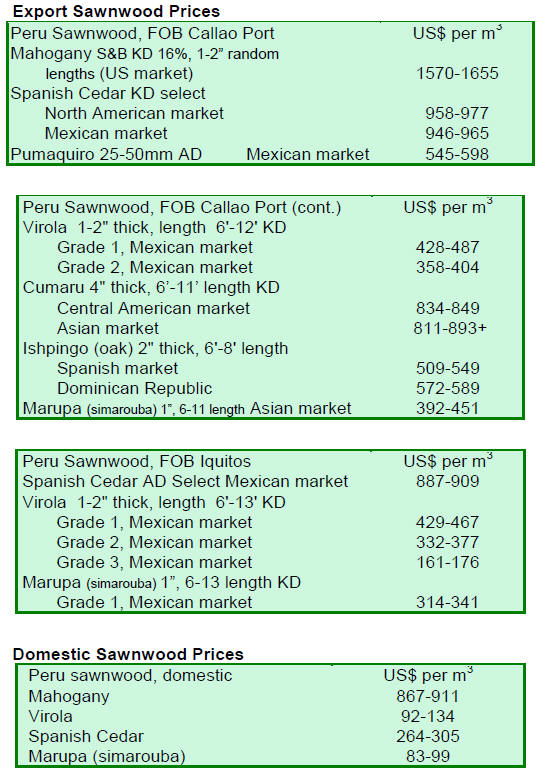
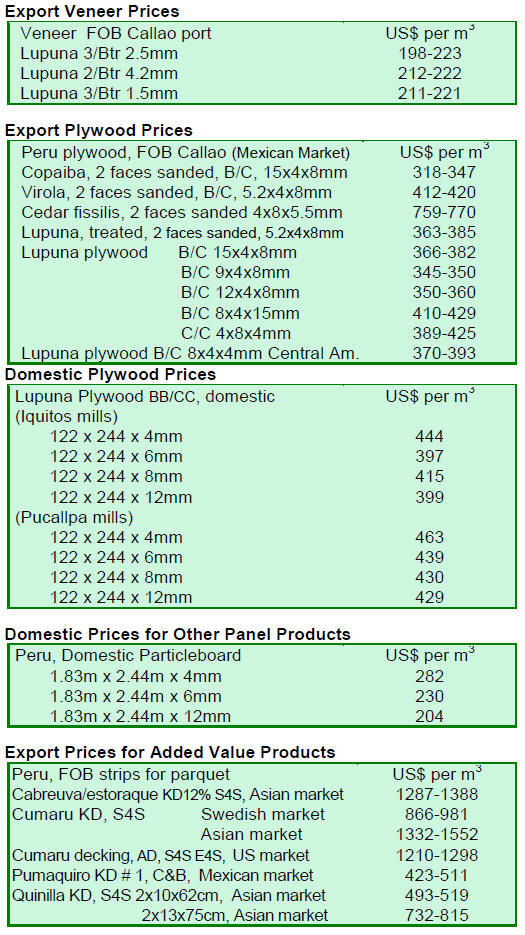
9.
GUYANA
Wamara logs attract good prices
from Chinese buyers
During the period reviewed there were no exports of greenheart logs and only
a small volume of Standard sawmill quality purpleheart were exported. Prices
for purpleheart logs were around US$235 per cubic metre.
Mora log export prices remain firm and during the period reviewed. Exports
of wamara (Swartzia leiocalycina) logs made a positive contribution to
overall export earnings attracting prices as much as US$160 per cubic metre
for Fair Sawmill quality logs. China was the main destination for logs from
Guyana.
Sawnwood prices vary in market with little direction
Sawnwood exports made a fair contribution to total export earnings and FOB
prices have been encouraging prices during the past weeks.
Undressed greenheart (Select category) top end FOB prices dipped from
US$1,357 to US$ 1,060 per cubic metre. During the period of this report FOB
prices for Undressed greenheart (Sound category) earned a top end price of
US$806 per cubic metre while Undressed greenheart (Merchantable category)
FOB prices moved up from US$551 to US$594 per cubic metre.
There was little trade in Undressed purpleheart sawnwood with only the
Merchantable category being traded however FOB prices were satisfactory at
US$650 per cubic metre.
Mora sawnwood FOB prices remained stable at around US$500 per cubic metre
FOB for both the Select and Merchantable Undressed categories. Undressed
sawnwood is traded to markets in the Caribbean, Europe and North America.
Dressed greenheart sawnwood top end FOB prices fell significantly from
US$1,500 to US$ 1,060 per cubic metre, while Dressed purpleheart sawnwood
top end FOB prices remain firm at US$1,102 per cubic metre. The Caribbean
was the prime market for Dressed sawnwood.
Exports of Guyana¡¯s ipe (locally called washiba) yielded a record high FOB
price of US$2,900 per cubic metre in the US market.
Guyana¡¯s plywood export prices continues to hold firm at US$584 per cubic
metre while prices for splitwood (shingles) earned US$909 per cubic metre
FOB with the Caribbean being the main market.
Exports of piling and posts continue and favourable prices were achieved.
Prices for posts went as high as US$700 per cubic metre in the Caribbean
market while piling prices were at US$586 per cubic metre FOB for the US
market.
Technical Working Group meets with key stakeholders
The VPA process is moving within the agreed timeline in the ¡®roadmap¡¯.
The National Technical Working Group (NTWG) held meetings with key
stakeholder groups to continue consultations and address concerns raised.
National consultations will commence on key aspects such as the Legality
Definition and the structure of a Legality Assurance System.
A third Technical Meeting (video conference) was held on the 5th of June and
focused on the updated Legality Definition, the Wood Tracking System (WTS)
and the Legality Assurance System (LAS).
It was agreed that another video conference would be required in order to
address some of the details and concerns in relation the Legality
Definition.
Preparations are being made for the second round of negotiation scheduled
for the 15th - 19th July, 2013 which will be attended by the NTWG. The
disussions in Brussels will allow members of the NTWG to better understand
the processes involved when wood products enter the EU market.
Guyana will participate in the Chatham House
meeting in July and representatives from the private sector, government and
civil society will also attend.
Developing the VPA communication strategy and scoping
The process of recruiting consultants for the design of the communication
strategy and the scoping impacts of the VPA has commenced.
It is expected that the consultants selected will have a very good
understanding of the local situations to adequately address the needs of the
sector.
The Communication Strategy is an integral aspect in the VPA since provides
for the most appropriate means of communication with stakeholder groups to
ensure the right messages go out and provide for feedback.
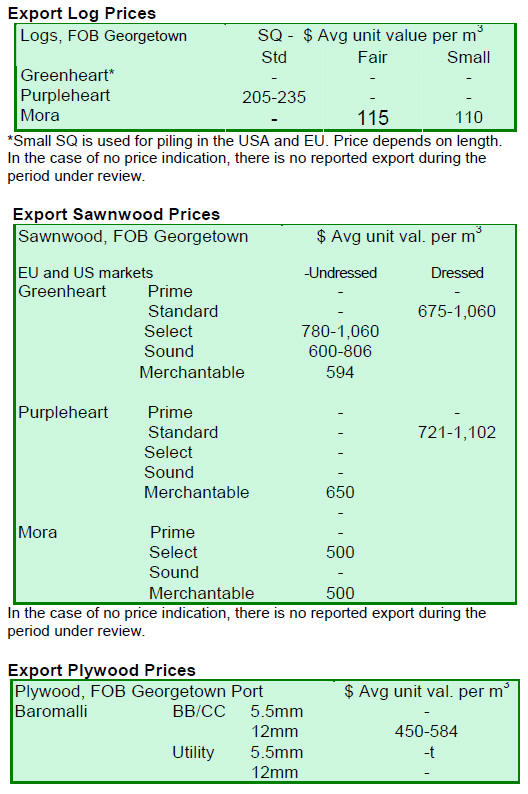
¡¡
